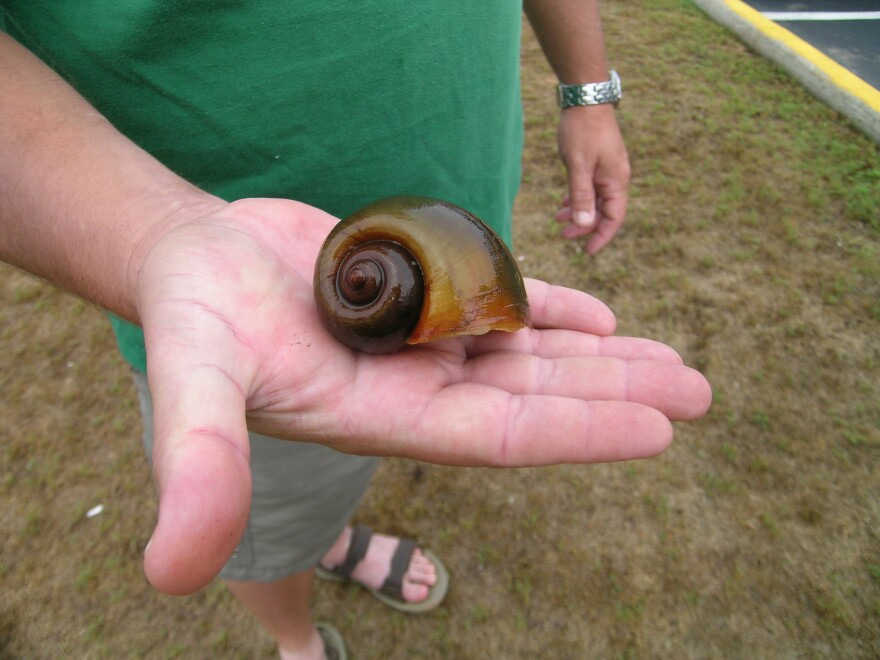As climate change increases global and oceanic temperatures, creatures are reacting by moving into areas they haven’t before lived. They’re termed “invasive species” and among the suggestions for eradicating them is to sauté, grill, fry, or bake them.
Several invasive species have made their way to North Carolina in recent years. Last year, apple snails were found along the Lumber River in Lumberton. Lionfish, which originally made their home in the Indian Ocean, were first seen in North Carolina waters in the early 2000s. And the Florida everglades are overrun by python that can grow to 18 feet…and are expected to eventually make their way to the Carolinas.
Growing in popularity – among some scientists, naturalists, and web-based cooking videos and books is the concept of “eating invasive.”
Recipes abound for dishes like “Southern Fried Python,” “Burmese Python Nuggets,” and “Cajun Style Grits and Python.” Most say the snake filets taste like chicken.
Python previous coverage — Burmese Pythons and their eventual trek to the North Carolina Coast
Dr. Mike Cove, mammalogy research curator at the North Carolina Museum of Natural Sciences, isn’t so sure that eating the snakes is a good plan for eradicating them.
"Especially apex predators can accumulate lots of different heavy metals or vitamins or other toxicants from the environment, from their prey, and accumulate them at high levels that would make it unsafe for folks like us to eat," he explained.
However, he encourages people to eat another invasive – the Lionfish. Cove said the destructive, spiny fish is a delicacy in other places and is completely safe to eat for those that know how to clean them.
"They have quite tasty fillets," he said, "It just takes a little bit of expertise to make sure that you avoid their venomous spines when you cut the fins off but they're actually quite tasty and occur on many menus in the Caribbean and in South Florida.”
Lionfish are voracious eaters that have no natural predators in the Atlantic Ocean, and they will eat all the young fish and crustaceans that eastern North Carolina commercial fishers and local restaurants rely on.

Previous lionfish coverage — Underwater Fishing Tournament Targets Invasive Fish Species
North Carolina has the seventh worse feral hog problem in the U.S. and they’ve been spotted in 85 North Carolina counties. Cove says that’s another invasive that could be served up as a tasty barbeque treat.
"Feral hogs are, you know, just an extension of domestic pigs and in many cases that can be quite tasty meat and hunting them could help manage their population expansion," Cove said.
And one nuisance species could go on the weekly menu…for those with a strong constitution. Cove said, "I'm not so sure that we're going to convince the people of North Carolina or the people of the United States that we should be cooking the mice in our garage but there is a huge proportion of the global population that eats rats.” He added, "It's not to say that the non-native black rats, brown rats would be the two species that we have here in North Carolina, are necessarily going to be tasty but is actually quite a bit of meat on them if you consider that they can be about the size of a small Cornish game hen or something like that.”
Research Curator of Mollusks at the North Carolina Museum of Natural Science Art Bogan has traveled the world and made the most of the opportunity to explore varied cuisines. There is one thing he’s more cautious with, though. (Trigger warning, some people in eastern North Carolina might find this blasphemous.)
"One of the things I have I do have difficulties with -- things like oysters," he said, "Because they're filtering water in and if it's an area that has any sort of pollution problems or outflow problems, then it might be a health hazard.”
When it comes to the apple snail that was first found in eastern North Carolina last summer, though, Bogan says it would make an excellent meal.
"The little trapdoor, the operculum, the little thumbnail like thing that is a trap door and you can't eat that, so you spit that out, but the rest of it’s a nice piece of protein," Bogan said.

Previous coverage: Apple snails, Another invasive aquatic species has been found in North Carolina
Bronwyn W. Williams, Research Curator of Non-Molluscan invertebrates at the North Carolina Museum of Natural Sciences, says the push to eat invasives may actually cause other harms.
The Red Swamp Crayfish is a Louisiana native that was likely introduced to North Carolina in a bait-bucket or as an aquarium escapee, and Williams said, "Eating the invasive crayfish species is actually what got them onto the landscape in the first place.”
Because they’re so sought after by foodies, she fears that people will want to intentionally introduce them in areas where they could harm the state’s native crayfish.
"“Trying to get people to understand that if you buy live crayfish for crawfish boil something along those lines, that's wonderful," she said, but added, "If you don't use all of them, please, please, please don't dump them into the nearest stream.”
There are more edible invasives in North Carolina, like Kudzu – and a push to eat, “the plant that ate the south.” According to cookbook authors, it has a mild spinach-like flavor and its flowers taste like a grape-apple combination to some, and a strawberry-apple to others.
As common as they are, dandelions are also considered an invasive species; but according to many recipes, young dandelion greens can make the base for salads…or soaked, boiled, and sautéed like collards and the flowers can be battered and deep fried.



